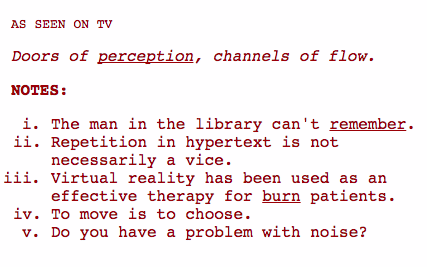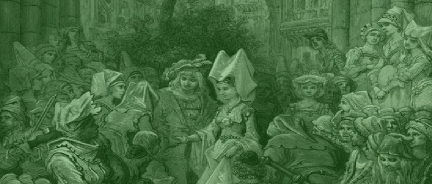Hyperrhiz 15
Rime of the Reagan Library: Remixing Digital Literature as a Critical Method
Richard Ness
Margaret Bertucci Hamper
Lauren Gottlieb-Miller
Citation: Ness, Richard, Margaret Bertucci Hamper and Lauren Gottlieb-Miller. “Rime of the Reagan Library: Remixing Digital Literature as a Critical Method.” Hyperrhiz: New Media Cultures, no. 15, 2016. doi:10.20415/hyp/015.e04
Analysis
In the mid-1960s, MIT computer scientist Joseph Weizenbaum created ELIZA/Doctor, a computer program in an emerging field called “natural language processing.” Eliza became well known for its ability to simulate a psychotherapist who could “thoughtfully” respond to questions posed by users. However, Weizenbaum was disappointed when Eliza was thought by users to be smart. He thought that Eliza users overestimated the computer’s ability and downplayed human ability, a fact that did not augur well for future computer users comprehending the programmable systems that run virtually every sector of society. The result was the “Eliza effect,” a phenomenon in which users overestimate the complexity of computer processes that are far simpler than they appear on the screen. Weizenbaum’s concern — too much trust in computer systems coupled with ignorance of their processes — is shared by several recent theorists in the field of software studies, including Noah Wardrip-Fruin, Ian Bogost, and Wendy Hui Kyong Chun. The Eliza effect resonates with some of the larger problems being addressed by software studies theorists, who believe that going beyond the interface level and learning the invisible processes at the level of code can have a substantive social impact. We argue that electronic literature such as Stuart Moulthrop’s Reagan Library, the subject of our project, is a highly effective way to address this concern as electronic literature compels readers to investigate both the processes that work at the level of code and the rhetoric embedded in those processes that lie beneath what is visible on the computer screen.
To connect Reagan Library to the larger social context delineated by Chun — rethinking memory and storage in a neoliberal age — it is not insignificant that Moulthrop chose a neoliberal political figure as the kernel for his project. According to Chun (8), software systems are the “grid of intelligibility” and cannot be reduced to code or algorithm because they structure our epistemological and discursive fields as well as our modes of living. Software draws parameters for what can be articulated and performed. Electronic literature such as Reagan Library compels us to read its code and examine its processes in order to fully understand its narrative. This is a reading model that gives readers the motivation, ability, and vocabulary to understand the invisible rhetorical processes embedded in the software systems that structure our economic, political, and social networks. Chun argues that, while computer systems make processes more invisible than ever, the possibilities of understanding processes are greater than ever — as software erases human agency, it also creates opportunities for understanding (2). Electronic literature such as Reagan Library is one such opportunity.






By compelling readers to examine code, electronic literature exposes the invisible, underlying processes of software systems that form the operational basis for social, economic, and political life. This is one reason why Noah Wardrip-Fruin, in Expressive Processing: Digital Fictions, Computer Games, and Software Studies, insists on reading beyond “surface output,” suggesting that the understanding of code is an empowering analytical tool that will make social processes more legible (xii). Similarly, Ian Bogost suggests that a study of “procedural rhetoric” will provide insight into the invisible, revealing the ideologies embedded in software codes that shape politics, education, and advertising (ix). For Chun, this speaks to how the invisible (code and algorithm) and the visible (surface output and GUIs) combine to create trust in computer systems (2). Electronic literature pushes us beyond what Matthew Kirschenbaum calls “screen essentialism” (19).
In current debates about electronic literature, we argue that there is too much emphasis on the literature itself and not enough on developing new analytical methods for making meaning out of that literature. Traditional novels and digital fiction perform similar cultural functions, only in different ways. Novels question ideologies, address social problems, and expose what is hidden while giving readers a vocabulary to do the same. But to analyze electronic fiction on its own terms, we must explore new critical methods. We argue that remixing is a key method for engaging electronic literature because it allows us to access the expressive capacity of computational processes, and enables us to understand the rhetorical constraints and allowances embedded in software.
Since Reagan Library’s narrative evolved out of pictures, and not the other way around as one might expect, it seems appropriate enough to begin with an analysis of those pictures, that is to say the novel’s visual rhetoric (Moulthrop, personal). The reader of Reagan Library will eventually notice that the four worlds (red, blue, green, and black) depict the same landscape, only in different colors and from varying perspectives, producing the effect of a parallax. Before he wrote the text, Moulthrop was already making a rhetorical move as this very structure poses a non-verbal argument: that an object or event will always have competing interpretations and that multiple perspectives are required to gain sufficient understanding of that object or event because viewers bring assumptions and personal histories to the objects they examine, just as readers do with texts. This initial authorial choice is both expressive and rhetorical, and it exemplifies what Wardrip-Fruin calls “expressive processing” and what Ian Bogost calls “procedural rhetoric.” Reagan Library’s text grew out of this visual argument and the narrative adopts this argument as well: the four different worlds (red, blue, green, and black) correspond to four narratives that unfold simultaneously in ways that mark them as discrete even though visual and textual elements from the four worlds bleed into one another. The worlds have similarities and differences in the way they are experienced, remembered, and forgotten. Moulthrop’s argument also extends to the reader as the novel’s code forbids any two readings from being identical; thus, the reader makes choices and is an active agent in how the narrative unfolds. This structural and procedural argument is expressed in the code, which is purposely written to randomize hyperlinks so that no page will repeat. This is a very innovative feature as hyperlinks are typically predefined. The red world informs the reader that the pictures are panoramic, and when the reader discovers this feature, the visual and narrative rhetoric become even more persuasive, or at least visible, as it highlights the simultaneous sameness and difference of each world.
But as Reagan Library suggests, key to our experiences are the different ways in which we store and lose memory. In the narrative itself, the static texts, since they repeat, function metonymically as memory. Yet, because the “sententious,” “fragmentary,” “nominal,” “advice,” and “numeric” functions interweave random sentences into the static text, adding some new text while discarding some old text, that memory is never experienced in the same way.
Game of Fiction?
Reagan Library asks the question, “is it fiction or is it a game?,” which is echoed in statements like “this is not a game” and “it’s not that this is not a game.” Of course, posing the question suggests that Reagan Library is a game-fiction hybrid, or at least that it uses the processes of both. Reagan Library’s processes are much like that of a game. In Expressive Processing, Wardrip-Fruin delineates the difference between three effects, devoting a chapter to each: The Eliza effect, which we explained; The Tail-Spin Effect, which is the inverse of the Eliza effect in that its underlying processes are more complex than they appear at the interface level. We believe Reagan Library leans more toward a Sim City effect in that the red world subtly reveals its mechanisms through clues, thus functioning as a meta-narrative between author and reader. However, it is not exactly a Sim City effect since Reagan Library’s Red World uses words instead of procedures to reveal its mechanisms, although an argument can be made that the textual clues are so cryptic that they function more as gaming procedures rather than verbal explanations or instructions (see Figure 7). Nevertheless, while Reagan Library has a Sim City-like effect, the actual effect of textual gaming — a sort of hybrid of the Sim City effect and textual analysis. One could say that Reagan Library invites a sort of participatory close reading. As the reader discovers the differences between the four worlds, reaching new levels and reading increasingly static text, she learns Reagan Library’s rules and parameters, creating a dynamic of intermediation. As the novel-game engages the reader in this way, the reader becomes more of a reader-player — a participant in how the narrative unfolds (Wardrip-Fruin 366).

This participatory dynamic is partly why Wardrip-Fruin calls electronic fictions “textual instruments” or “texts meant to be played” (365-66). Moulthrop, in an interview with Wardrip-Fruin, compares the expressive processes of digital fiction to playing a guitar. Moulthrop suggests, “a good instrument…would stimulate engagement. It should make people want to get in there and interact, and to repeat the experience” (Moulthrop, qtd. in Wardrip-Fruin 367). Learning the process of playing a guitar stimulates and, consequently, invites one to interact. Reagan Library exemplifies Moulthrop’s search for the middle ground between games and fiction: “I’m particularly taken with…the notion of a middle space between literary texts and ludic texts” (qtd. in Wardrip-Fruin 367). The former hides its processes while the latter reveals its process by engaging the reader-player. The reader-player gets clues from the Red World and uses those clues to detect patterns in the other worlds. The surface narrative of Reagan Library is extremely opaque, but becomes more intelligible as the reader-player interacts with its rules and learns its processes, interpreting clues as she navigates her way through the hyperlinks.
That is the experience of Reagan Library at the interface level, but to truly understand Moulthrop’s hypertext novel, we must get beyond the interface and into the invisible level of code, where expressive processes and procedural rhetoric reside. Wardrip-Fruin suggests that the reason a lot of process-driven work is dismissed as too opaque or uninteresting is because it is judged only by its “surface output” and not by what is invisible — its processes and the code that defines the rules and parameters of those processes (354). Consequently, hypertext fiction, electronic literature, and “textual instruments,” are often trivialized or maligned. In Reagan Library, Moulthrop sardonically suggests that some academics consider electronic literature to be “crimes against the humanities.” According to Wardrip-Fruin, this is to misunderstand the scope, the intent, and the potential of digital literature, suggesting that we must look through surface output and examine processes.
Examining process is not a discrete activity from reading, but rather part of the reading experience, what Espen Aarseth calls “ergodic reading.” Reagan Library makes numerous references to this in its refrain “Ergodics for the masses,” which is programmed to be randomly intertwined with static text. Ergodic reading — reading that, according to Aarseth, entails “non-trivial” events and choices — is invoked by the red world’s clue, “to move is to choose.” Instead of turning the page, the reader decides what link to click based on the ambiguous clues she receives while visiting the red world (or in the instructions stated in the ground rules). For example, the rule “some links have a greater claim to coherence” draws the reader in as an active participant in the narrative as she attempts to figure out which link on each page will produce the most coherence.
As digital media requires a new rhetorical vocabulary to accommodate its procedures, electronic literature requires new heuristics to be understood on its own terms. While close, historical, or deconstructive readings are useful, they would ultimately prove inadequate for a hypertext novel. Analytical methods that help us understand digital media must include the examination of processes, the reading of code alongside narrative, and the use of remixing as an interpretive instrument. Wardrip-Fruin gives an example of the latter in Expressive Processing, substituting Medusa and Perseus for Anna and Freud in order to interpret Freud’s case study on Anna. To successfully read electronic literature, readers need to deploy what N. Katherine Hayles calls “media specific analysis, in which the physical nature of a medium is not incidental, but central to the analysis” (68-9). A successful interpretation of a hyper-text novel must account for that text’s materiality — its images, its fluidity, and its combination of code with natural language (Hayles 68-9). This is our objective in remixing Reagan Library with Samuel Taylor Coleridge’s Rime of the Ancient Mariner.




The code for Reagan Library is written to gradually create the sense that the reader is caught in an endless cycle (the endless cycle signals to the reader that she has completed the narrative). At the level of process, this code thematizes the cycle of endless tale telling that forms the outer frame of Rime’s structure, which suggested to us a connection between the code and content, much like the relationship between poetic form and content. This is another reason for reading code as poetry. Like code, poetic forms and formal elements put procedural constraints on what can be said and how it can be said. The material elements of poetry — rhyme, meter, and sound — whether they are fixed or whether they vary within a poem, are not only expressive, but they provide analytical inroads to the production of meaning. In Reagan Library code is a crucial interpretive inroad. When close reading a traditional poem, for example, form and content are typically read as mutually reinforcing. Poetic structures are more visible that those of prose, which are more diffuse, and this is one of the reasons we thought it more appropriate to remix Reagan Library with poetry instead of fiction. Furthermore, the brief snippets of text in Reagan Library read more like stanzas than prose fiction, and its code could be said to provide poetic form. In traditional close reading, the connection between form and content has long been evident, as both a process and a heuristic. The same connection needs to be made between code and natural language. On a larger scale, connections need to be made between software systems and social, political, and economic opportunities they enable and constrain. Hypertext fiction? Hypertext poetry? Neither term seems particularly adequate for what Reagan Library is. While electronic literature like Reagan Library requires new analytical methods like remixing, it also compels us to rethink genre.
Cognitive overload encountered in 74 seconds »